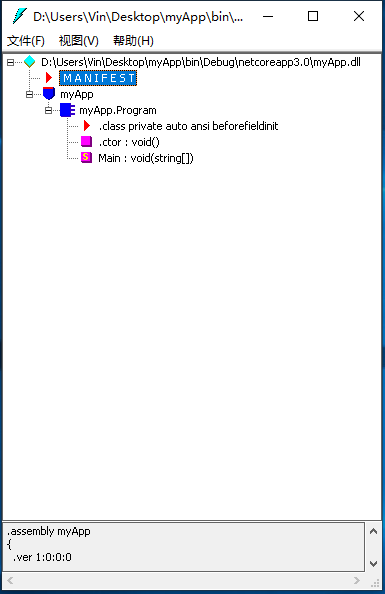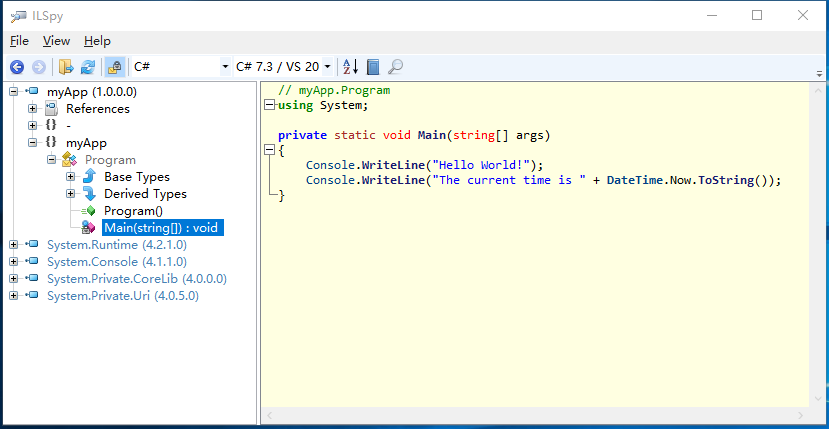[doc]
处理器不能直接解释程序集。程序集用的是另一种语言,即公共中间语言(Common Intermediate Language,CIL),或称为中间语言(IL)1。
C# 编译器将 C# 源代码文件转换成中间语言。为了将 CIL 代码转换成处理器能理解的机器码,还要完成一个额外的步骤(通常在运行时进行)。该步骤涉及 C# 程序执行的一个重要元素:VES(Virtual Execution System,虚拟执行系统)。VES 也称为运行时(runtime)。
它根据需要编译 CIL 代码,这个过程称为即时编译或 JIT 编译(just-in-time compilation)。如代码在像“运行时”这样的一个“代理” 的上下文中执行,就称为托管代码(managed code),在“运行时”的控制下执行的过程则称为托管执行(managed execution)。
之所以 称为“托管”,是因为“运行时”管理着诸如内存分配、安全性和 JIT 编译等方面,从而控制了主要的程序行为。执行时不需要“运行时”的代码称为本机代码(native code)或非托管代码(unmanaged code)。
说明:“运行时”既可能指“程序执行的时候”,也可能指“虚拟执行系统”。为明确起见,用“执行时”表示“程序执行的时候”,用“运行时”表示负责管理 C# 程序执行的代理。2
“运行时”规范包含在一个包容面更广的规范中,即 CLI(Common Language Infrastructure,公共语言基础结构)规范。作为国际标准,CLI 包含了以下几方面的规范:
- VES 或“运行时”。
- CIL。
- 支持语言互操作性的类型系统,称为 CTS(Common Type System,公共类型系统)。
- 如何编写通过 CLI 兼容语言访问的库的指导原则,这部分内容具体放在公共语言规范(Common Language Specification,CLS)中。
- 使各种服务能被 CLI 识别的元数据(包括程序集的布局或文件格式规范)。
在“运行时”执行引擎的上下文中运行,程序员不需要直接写代码就能使用几种服务和功能,包括:
- 语言互操作性:不同源语言间的互操作性。语言编译器将每种源语言转换成相同中间语言(CIL)来实现这种互操作性。
- 类型安全:检查类型间转换,确保兼容的类型才能相互转换。这有助于防范缓冲区溢出(这是产生安全隐患的主要原因)。
- 代码访问安全性:程序集开发者的代码有权在计算机上执行的证明。
- 垃圾回收:一种内存管理机制,自动释放“运行时”为数据分配的空间。
- 平台可移植性:同一程序集可在多种操作系统上运行。要实现这一点,一个显而易见的限制就是不能使用平台特有的库。所以平台依赖问题需单独解决。
- BCL(基类库):提供开发者能(在所有 .NET 框架中)依赖的大型代码库,使其不必亲自写这些代码。
注意: 本篇只是简单介绍了 CLI,目的是让读者熟悉 C# 程序的执行环境。此外,本篇还提及了本系列博文后面才会用到的一些术语。在时机合适的时候,我会专门总结 CLI 及其与 C# 的关系。
CIL 和 ILDASM
前面说过,C# 编译器将 C# 代码转换成 CIL 代码而不是机器码。处理器只理解机器码,所以 CIL 代码必须先转换成机器码才能由处理器执行。可用 CIL 反汇编程序将程序集解构为 CIL。通常使用 Microsoft 特有的文件名 ILDASM 来称呼这种 CIL 反汇编程序(ILDASM 是 IL Disassembler 的简称),它能对程序集执行反汇编,提取 C# 编译器生成的CIL。
反汇编 .NET 程序集的结果比机器码更易理解。许多开发人员害怕即使别人没有拿到源代码,程序也容易被反汇编并曝光其算法。其实无论是否基于 CLI,任何程序防止反编译唯一安全的方法就是禁止访问编译好的程序(例如只在网站上存放程序,不把它分发到用户机器)。
但假如目的只是减小别人获得源代码的可能性,可考虑使用一些混淆器(obfuscator)产品。这种产品会打开 IL 代码,转换成一种功能不变但更难理解的形式。这可以防止普通开发者访问代码,使程序集难以被反编译成容易理解的代码。除非程序需要对算法进行高级安全防护,否则混淆器足矣。
查看 myApp.dll 的 CIL 输出
myApp.dll 程序请参考这篇文章:https://www.vinanysoft.com/c-sharp-basics/introducing/start-with-hello-world/
安装了 Visual Studio 之后 ILDASM 会默认被安装,位置是:C:\Program Files (x86)\Microsoft SDKs\Windows\v10.0A(随便一个目录)\bin\NETFX 4.8 Tools(随便一个目录)\x64。
双击运行 ildasm.exe,把 myApp.dll 拖进去,如下图:

双击即可查看到 IL 代码,下面是 MANIFEST 的 IL 代码
// Metadata version: v4.0.30319
.assembly extern System.Runtime
{
.publickeytoken = (B0 3F 5F 7F 11 D5 0A 3A ) // .?_....:
.ver 4:2:1:0
}
.assembly extern System.Console
{
.publickeytoken = (B0 3F 5F 7F 11 D5 0A 3A ) // .?_....:
.ver 4:1:1:0
}
.assembly myApp
{
.custom instance void [System.Runtime]System.Runtime.CompilerServices.CompilationRelaxationsAttribute::.ctor(int32) = ( 01 00 08 00 00 00 00 00 )
.custom instance void [System.Runtime]System.Runtime.CompilerServices.RuntimeCompatibilityAttribute::.ctor() = ( 01 00 01 00 54 02 16 57 72 61 70 4E 6F 6E 45 78 // ....T..WrapNonEx
63 65 70 74 69 6F 6E 54 68 72 6F 77 73 01 ) // ceptionThrows.
// --- 下列自定义特性会自动添加,不要取消注释 -------
// .custom instance void [System.Runtime]System.Diagnostics.DebuggableAttribute::.ctor(valuetype [System.Runtime]System.Diagnostics.DebuggableAttribute/DebuggingModes) = ( 01 00 07 01 00 00 00 00 )
.custom instance void [System.Runtime]System.Runtime.Versioning.TargetFrameworkAttribute::.ctor(string) = ( 01 00 18 2E 4E 45 54 43 6F 72 65 41 70 70 2C 56 // ....NETCoreApp,V
65 72 73 69 6F 6E 3D 76 33 2E 30 01 00 54 0E 14 // ersion=v3.0..T..
46 72 61 6D 65 77 6F 72 6B 44 69 73 70 6C 61 79 // FrameworkDisplay
4E 61 6D 65 00 ) // Name.
.custom instance void [System.Runtime]System.Reflection.AssemblyCompanyAttribute::.ctor(string) = ( 01 00 05 6D 79 41 70 70 00 00 ) // ...myApp..
.custom instance void [System.Runtime]System.Reflection.AssemblyConfigurationAttribute::.ctor(string) = ( 01 00 05 44 65 62 75 67 00 00 ) // ...Debug..
.custom instance void [System.Runtime]System.Reflection.AssemblyFileVersionAttribute::.ctor(string) = ( 01 00 07 31 2E 30 2E 30 2E 30 00 00 ) // ...1.0.0.0..
.custom instance void [System.Runtime]System.Reflection.AssemblyInformationalVersionAttribute::.ctor(string) = ( 01 00 05 31 2E 30 2E 30 00 00 ) // ...1.0.0..
.custom instance void [System.Runtime]System.Reflection.AssemblyProductAttribute::.ctor(string) = ( 01 00 05 6D 79 41 70 70 00 00 ) // ...myApp..
.custom instance void [System.Runtime]System.Reflection.AssemblyTitleAttribute::.ctor(string) = ( 01 00 05 6D 79 41 70 70 00 00 ) // ...myApp..
.hash algorithm 0x00008004
.ver 1:0:0:0
}
.module myApp.dll
// MVID: {29FC93A2-9A52-445C-A581-09AA5BCC11C7}
.imagebase 0x00400000
.file alignment 0x00000200
.stackreserve 0x00100000
.subsystem 0x0003 // WINDOWS_CUI
.corflags 0x00000001 // ILONLY
// Image base: 0x000002015D090000
.class private auto ansi beforefieldint
.class private auto ansi beforefieldinit myApp.Program
extends [System.Runtime]System.Object
{
} // end of class myApp.Program
.ctor:void()
.method public hidebysig specialname rtspecialname
instance void .ctor() cil managed
{
// 代码大小 8 (0x8)
.maxstack 8
IL_0000: ldarg.0
IL_0001: call instance void [System.Runtime]System.Object::.ctor()
IL_0006: nop
IL_0007: ret
} // end of method Program::.ctor
Main:void(string[])
.method private hidebysig static void Main(string[] args) cil managed
{
.entrypoint
// 代码大小 42 (0x2a)
.maxstack 2
.locals init (valuetype [System.Runtime]System.DateTime V_0)
IL_0000: nop
IL_0001: ldstr "Hello World!"
IL_0006: call void [System.Console]System.Console::WriteLine(string)
IL_000b: nop
IL_000c: ldstr "The current time is "
IL_0011: call valuetype [System.Runtime]System.DateTime [System.Runtime]System.DateTime::get_Now()
IL_0016: stloc.0
IL_0017: ldloca.s V_0
IL_0019: call instance string [System.Runtime]System.DateTime::ToString()
IL_001e: call string [System.Runtime]System.String::Concat(string,
string)
IL_0023: call void [System.Console]System.Console::WriteLine(string)
IL_0028: nop
IL_0029: ret
} // end of method Program::Main
最开头是清单(manifest)信息。其中不仅包括被反编译的模块的全名(myApp),还包括它依赖的所有模块和程序集及其版本信息。
基于这样的一个 CIL 代码清单,最有趣的可能就是能相对比较容易地理解程序所做的事情,这比阅读并理解机器码(汇编程序)容易多了。
上述代码出现了对 System.Console.WriteLine() 的显式引用。 CIL 代码清单包含许多外围信息,但如果开发者想要理解 C# 模块(或任何基于 CLI 的程序)的内部工作原理,但又拿不到源代码,只要作者没有使用混淆器,理解这样的 CIL 代码清单还是比较容易的。
事实上,一些免费工具(比如 Red Gate Reflector,ILSpy,JustDecompile,dotPeek 和 CodeReflect)都能将 CIL 自动反编译成 C#。
使用 ILSpy 查看 myApp.dll 反编译后的代码
ILSpy 的地址:https://github.com/icsharpcode/ILSpy
双击运行 ILSpy.exe,把 myApp.dll 拖进去,如下图:
注意: 反汇编(disassemble)和反编译(decompile)的区别。反汇编得到的是汇编代码,反编译得到的是所用语言的源代码。
来源:https://www.cnblogs.com/vin-c/archive/2019/12/09/12011943.html
